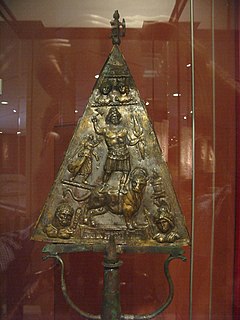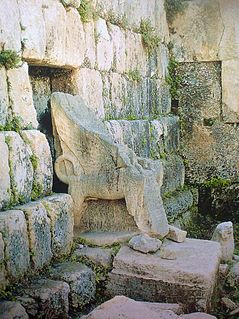Related Research Articles

In ancient Greek religion, Telesphorus was a minor child-god of healing. He was a possible son of Asclepius and frequently accompanied his sister Hygieia. He was depicted as a dwarf whose head was always covered with a cowl hood or cap.
The Illyrians were a group of Indo-European speaking tribes, who inhabited the western Balkan Peninsula in ancient times. They constituted one of the three main Paleo-Balkan populations, along with the Thracians and Greeks.

Lezhë or Lezha is a city in the Republic of Albania and the capital of the eponymous county and municipality.

Lambaesis (Lambæsis), Lambaisis or Lambaesa, is a Roman archaeological site in Algeria, 11 km (7 mi) southeast of Batna and 27 km (17 mi) west of Timgad, located next to the modern village of Tazoult. The former bishopric is also a Latin Catholic titular bishopric.

Apollonia was an Ancient Greek trade colony which developed into an independent polis, and later a Roman city in southern Illyria in classical antiquity. It was located on the right bank of the Aoös/Vjosë river, approximately 10 km from the eastern coast of the Adriatic Sea. Its ruins are situated in the county of Fier, close to the village of Pojan, in Albania.
Rhizon was a city in classical and Roman antiquity. Rhizon is the oldest settlement in the Bay of Kotor and the modern town of Risan stands near the old city. Originally it was an Illyrian settlement that developed gradually and became the capital of the Illyrian Ardiaean Kingdom under Agron and Teuta. It was the last stronghold of queen Teuta in the first Illyrian war against the Romans. It maintained its status as a significant regional settlement well into the Roman era.

Byllis or Bullis or Boullis (Βουλλίς) was an ancient city located in the transboundary region between southern Illyria and Epirus. The remains of Byllis are situated north-east of Vlorë, 25 kilometers from the sea in Hekal, Fier County, Albania.
The Ardiaei were an Illyrian people residing on territory of present-day Albania, Kosovo, Montenegro, and Bosnia and Herzegovina between Adriatic coast on the south, Konjic on the north, along the Neretva river and its right bank on the west, extending to Lake Shkodra to the southeast. From the 3rd century BC to 168 BC the capital cities of the Ardiaean State were Rhizon and Scodra.
Illyrian religion refers to the religious beliefs and practices of the Illyrian peoples, a group of tribes who spoke the Illyrian languages and inhabited part of the western Balkan Peninsula since at least the 8th century BC and until the 7th century AD. The available written sources are very tenuous. They consist largely of personal and place names, and a few glosses from Classical sources.

The Bylliones were an Illyrian tribe that lived near the Adriatic coast of southern Illyria, on the lower valley of the Aoös river, in the hinterland of Apollonia. The Bylliones were firstly attested in epigraphic material from the oracle of Dodona dating back to the 4th century BC, and their koinon was firstly attested in a 3rd century BC inscription from the same oracle. Their territory was trapezoidal on the right side of the rivers Luftinje and Aoös, extending in the west to the Mallakastra mountains. The chief city of their koinon was Byllis. Another important centre of their koinon was Klos, an earlier Illyrian settlement later called Nikaia, as an inscription attests. The Bylliones also inhabited in the area of an ancient sanctuary of the eternal fire called Nymphaion.

Jupiter Dolichenus was a Roman god whose mystery cult was widespread in the Roman Empire from the early-2nd to mid-3rd centuries AD. Like several other figures of the mystery cults, Jupiter Dolichenus was one of the so-called 'oriental' gods; that is Roman re-inventions of ostensibly foreign figures in order to give their cults legitimacy and to distinguish them from the cults of the traditional Roman gods.

The Temple of Eshmun is an ancient place of worship dedicated to Eshmun, the Phoenician god of healing. It is located near the Awali river, 2 kilometres (1.2 mi) northeast of Sidon in southwestern Lebanon. The site was occupied from the 7th century BC to the 8th century AD, suggesting an integrated relationship with the nearby city of Sidon. Although originally constructed by Sidonian king Eshmunazar II in the Achaemenid era to celebrate the city's recovered wealth and stature, the temple complex was greatly expanded by Bodashtart, Yatan-milk and later monarchs. Because the continued expansion spanned many centuries of alternating independence and foreign hegemony, the sanctuary features a wealth of different architectural and decorative styles and influences.

The Cape of Rodon or Cape of Skanderbeg is a rocky cape on the Adriatic Sea north of Durrës, Albania. On the Cape is the Rodoni Castle, built by Skanderbeg in 1463. and a Saint Anthony Church. Further south in the bay between the cape and Rrushkull Reserve there exist several beach resorts like Fshati Turistik Lura while Lalzit Bay Resort is under construction.
Sextus Julius Major was a Roman senator active during the first half of the second century, and who held several positions in the service of the emperor. Major was suffect consul around 126. Major's origins were with the "high aristocracy" of Asia Minor. Ronald Syme notes his ancestors included Polemon I the king of Pontus and Antonia Pythodoris.
Teuta was the queen regent of the Ardiaei tribe in Illyria, who reigned approximately from 231 BC to 228/227 BC.
The Balaites were an ancient tribe in southern Illyria, modern-day Albania. The tribe is known from a number of Greek inscriptions, otherwise unmentioned among ancient written sources.

Titus Caesernius Statianus was a Roman senator who held a number of appointments in the Imperial service during the reigns of Hadrian and Antoninus Pius. He was suffect consul in the nundinium of September-October 141; his colleague's name is not known. His full name is Titus Caesernius Statius Quinctius Statianus Memmius Macrinus.
This article contains information about Illyrian vocabulary. No Illyrian texts survive, so sources for identifying Illyrian words have been identified by Hans Krahe as being of four kinds: inscriptions, glosses of Illyrian words in classical texts, names—including proper names, toponyms and river names—and Illyrian loanwords in other languages. The last category has proven particularly contentious. The names occur in sources that range over more than a millennium, including numismatic evidence, as well as posited original forms of placenames. The Messapian language, which may or may not be related, does have a small attested corpus, but it is not in this page's scope due to the uncertainty about its relationship to Illyrian.
Nymphaion was the name given to the ancient sanctuary of the "eternal fire" located in southern Illyria, near Apollonia in modern day Albania. Placed inland on the Vjosë/Aoos river. Pliny the Elder mentions the area was inhabited by the local Illyrian Bylliones and Amantes and was at some point included in the broader territory of Apollonia. The ancient site has been identified with the Selenica area, across from Byllis, a region rich in natural reserves of petroleum and gas, which were required to feed the eternal fire. Selenicë is still a modern producer of hydrocarbons and high quality bitumen.
References
- 1 2 3 Dyczek et al. 2014, pp. 81.
- 1 2 Wilkes 1995, pp. 244–245.
- ↑ Ceka 2013, p. 414.
- 1 2 3 Dyczek et al. 2014, pp. 82–83.
- 1 2 3 Dyczek et al. 2014, pp. 73–74.
- ↑ Dyczek et al. 2014, pp. 77.
- ↑ Dyczek et al. 2014, pp. 79–80.
- ↑ Várhelyi, Zsuzsanna (2010). The Religion of Senators in the Roman Empire: Power and the Beyond. Cambridge University Press. p. 34. ISBN 978-1-139-48761-0.
- 1 2 3 4 Dyczek et al. 2014, pp. 81–83.